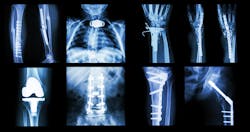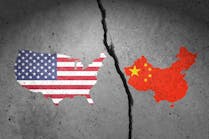Orthopedic strategies: Deference to physician preference for patient reference
To borrow some literary cues from author Ernest Hemingway, the notion of supply chain working with orthopedic surgeons to procure needed products and supplies resembles the fictional character Harry and his quest to reach the mountain summit in “The Snows of Kilimanjaro.”
In an idyllic patient-focused clinically driven business environment, supply chain and orthopedic surgeons partner harmoniously to obtain and use what they deem necessary to fix and heal the patient. Although the partnership stops just short of the quirky and quixotic nature of a buddy-cop film or television show, the clinical and economic value that it brings to the healthcare system and the patients served motivates one wonder about why it took so long to materialize.
Unfortunately, professional relationships either resembling or moving toward this model may be more the exception than the rule as an antagonistic chasm between clinical and business interests historically has been deep and wide with orthopedic product suppliers hopscotching across the gorge.
Orthopedic surgeons, by and large, see Supply Chain as more concerned about the bottom line, costs and pricing that seemingly supersedes the delivery of high-quality patient care. They’d rather force clinicians to change how they perform surgery with unfamiliar products to satisfy a contractual obligation without clinician support in any way.
Supply Chain, on the other hand, by and large, see orthopedic surgeons—conceivably corralled by Operating Room directors—as elitists who simply want their preferred devices, products, and supplies regardless of cost and under the impression that the hospital will slash budgets elsewhere to make up the difference and remain afloat.
Several issues actually hinder the arguments of either side. They include all the treats, trinkets and trips that vendors still shower on clinicians to curry favor. And while tightening ethical rules may have slowed the torrent to something closer to a sprinkle or trickle, favors still occur throughout the profession. Further, select vendors still recruit clinicians to “design” or “endorse” certain products for sale, which can generate healthy residual payments to those clinicians. Some vendors also allow their reps (passively or otherwise) to sidestep established contractual relationships and credentialing procedures by directly selling “trunk stock” through the back door in bill-only transactions that may not have internal OR approval or even awareness and acknowledgement by Supply Chain.
Meanwhile, less experienced, forward-thinking and seasoned Supply Chain managers may feel the C-suite is forcing their hand to crack down on costs by using product contracts as a clinical cudgel to get surgeons to toe the line.
Yet a growing number of healthcare organizations operate on the spectrum in between these two extremes as indicated by several supply chain trends that have developed and grown throughout the last few decades.
To wit: Supply Chain (capitalized to represent the department and not the function) recruits physicians to its team to serve as a bridge linking business and clinical interests; embraces and promotes evidence-based value analysis in all product and service decisions that heavily incorporate physician input; implements mutually beneficial cost-saving and revenue-sharing programs with the aim to fortify the bottom line as well as reinforce high-quality patient care delivery; and facilitates a trustworthy consulting relationship between the two sides under the recognition of a united endgame even if the ongoing journey meanders a bit.
So how well are orthopedic surgeons and supply chain strategically and tactically working together? Reviews remain mixed.
Looming challenges, obstacles
Operating independently of Supply Chain on business matters (versus clinical matters more directly involving patients), orthopedic surgeons face a flurry of hurdles.
One involves visibility, the lack of which can lead to deleterious economic consequences.
“Supply chain staff work tirelessly with their supplier partners to maintain purchasing commitments and without proper dialogue, a surgeon could unwittingly diminish price savings by utilizing a non-approved product,” he continued. “A surgeon who is interested in sourcing/purchasing off-contract products should work with his or her organization’s supply chain to balance the need for new products while maintaining contract compliance.”
Without supply chain’s support, orthopedic surgeons can be challenged in having the appropriate market intelligence and full information on a product category/segment, including the full scope of suppliers as well as new, innovative products they’re not currently using, according to Karen Niven, senior director, Operational Excellence and Clinical Value Analysis, Premier Inc.
Niven encourages healthcare organizations to set up a clinically integrated supply chain “to enable providers to recoup savings, collaborate with suppliers and obtain the high-quality products, supporting clinical evidence and the supplies necessary for outstanding patient care delivery.”
“The biggest challenge for surgeons is time,” Smith said. “Since time is a finite resource surgeons must strike a balance between caring for patients and taking care of business. Both are direct contributors to healthcare equity within the communities they serve. Partnering with Supply Chain allows certain parts of the process, such as sourcing, contracting and purchasing, to be delegated and managed by those whose expertise it is. Supply Chain professionals can also coordinate the evaluations of medical devices which provides valuable feedback in product decisions.”
Summed Jim Ferch, CEO and co-founder, Simplify OR, which makes software to manage medical device implants: “Each has specialized knowledge they bring to the table, surgeons and supply chain,” he noted. “Each can learn and grow through a collaborative journey of continuous product/process improvement.”
Working together
Even though the litany of challenges and obstacles should encourage orthopedic surgeons and supply chain professionals to collaborate creatively to ensure clinicians have what they need to deliver patient care while minding cost concerns for the organization that allows them to practice, sometimes the two groups must reach mutual compromises.
“Having a simple process with clearly defined expectations and excellent communication is the winning formula,” GHX Lumere’s Smith assured. “This builds trust between the surgeons, OR directors, supply chain and suppliers. Being aligned as a stakeholder group and understanding what each will contribute to the process facilitates speed to value and limits unexpected compromises from occurring.”
Premier’s Niven points to value analysis as the unifying strategy and tactic.
“A strong value analysis process, bringing clinicians and supply chain to the table, can provide decision support around product/services cost, quality, safety, outcomes and reimbursement,” Niven noted. “Practices that help reduce waste—the way we do in our own homes—can be used in the value analysis process as well. As one example, supply chain teams can work with physicians to focus on preference cards, remove unnecessary items and discuss practice variations.
“Teams can also dedicate a steadily increasing portion of a value analysis agenda for proactive assessment of critical procedures or Diagnosis-related groups (DRGs), examining products used within a procedure when issues with cost, quality, safety or outcomes are identified—and if revisions are necessary based on shared intelligence, data and best practices,” she added.
“First and foremost, all parties must have a seat at the table with clear objectives set for the organization,” he said. “Surgeons need to understand their cost per case. Representatives from the supply chain need to explain their supplier compliance requirements to operating room staff. Aligned incentives between physicians and supply chain is critical. Demonstrating that one surgeon’s total-knee arthroplasty averages $800 to $900 more per case than their colleagues’ with similar outcomes can start a great discussion on what that surgeon is doing differently than his or her peers. It’s entirely possible that the surgeon is unknowingly using a non-contracted product at a higher price point when he or she could be using a product that is just as safe and effective at negotiated pricing.”
That’s where computer software and data science comes into play, Simplify OR’s Ferch insists.
“Each has at their disposal a faculty of synthetic and creative ideas with which to work together to solve all the barriers of a collective agreement,” he noted. “There doesn’t have to be any compromise relative to quality of product that they consider if they mutually agreed to the idea of mutual gain.”
Beyond product preference
Yet data can be a stumbling block that prevents effective collaboration between surgeons and supply chain, according to Smith.
“Organizations which have had the most success working on orthopedic initiatives spend time up front making sure their data is accurate and actionable,” she said. “They analyze supply chain and [electronic health record] data to ensure the best results financially and clinically. Looking at data sets through diverse points of view avoids potential delays if not all factors are considered up front. Educating clinicians and suppliers about policies and expectations and taking swift action when needed is essential to vendor partnerships.”
Ferch points to data’s location as potentially problematic.
“Data is stratified between enterprise systems, or enterprise silos,” he said. The electronic health record for structured patient demographics and financial services data, the ERP has structured item data demographics and financial data, and the vendor contract files, where agreed to and structured pricing over a term is maintained.
“Supply chain needs to take a holistic approach and merge these siloed systems to develop a landscape of product strategies and value propositions with their surgeons,” Ferch added.
Howard emphasizes the mutual accessibility of data as buttressing collaboration between surgeons and supply chain that covers orthopedic products.
“A key challenge facing supply chain staff is the lack of robust cross-reference capabilities for orthopedic products,” he noted. “Providers look for alternative products to bolster supply assurance. Supply chain staff must work proactively with both device manufacturers and clinical teams to fully understand what products are needed and what products can be offered. This increases potential conversion opportunities for price savings and provides a backup plan in the event of a manufacturer backorder or recall.”
Two issues remain at stake amid the surgeon-supply chain relationship, according to Niven.
The first involves the connection of products to patient outcomes.
“Supply chain teams and clinicians should look to create a foundation of holistic and robust data on which to rely,” she said. “While there is no substitute for the culture or staff needed to conduct value analysis, an all-in-one data, workflow and communications platform can aid in the evaluation of products and services and enable purchasing decisions that are both fiscally responsible and aligned with quality improvement.”
The second focuses on labor.
“There is significant demand—and a shortage of talent—for healthcare supply chain professionals at all levels,” Niven noted. “Changing skill requirements is one factor driving the labor shortage. We need to invest in education and training for the supply chain workforce of the future, including ensuring employees have advanced digital and analytical skills, which will remain critical competencies in supply chain roles. Additionally, a trusted workforce enhancement partner can help drive speed-to-value on the biggest-impact opportunities for a hospital supply chain team, support guidance on clinical integration and value analysis approaches, and help to lessen the burden on many stretched and already stressed teams.”
Enabling clinical integration
Even now as the industry enters the “post-pandemic” era, Supply Chain must cultivate strategies and tactics to initiate, maintain and improve their relationship with orthopedic surgeons and the OR.
Ferch recommends “data-driven scoring” to create trust between the surgeons and supply chain for “their toolbox of orthopedic products to delight the customer.” These include patient satisfaction scores (via the Hospital Consumer Assessment of Healthcare Providers and Systems or HCAHPS) and key performance indicators (KPIs).
Familiarity helps, too, according to Howard.
“The best strategy for Supply Chain to initiate is a meeting cadence (weekly, bi-weekly, or monthly) with orthopedic surgeons and OR staff,” he advised. “With reimbursements tightening and pricing constraints being amplified, everyone must be on the same page. As suppliers continue to provide more value for contracting models built on provider commitment, surgeons and Supply Chain must stay aligned. Any deviation from this could erode savings that were previously negotiated.”
Clinical-supply chain integration and value analysis have found renewed purpose in a post-pandemic world, Niven insists. “More organizations are turning to process improvement and lean strategies for ways to find savings, and simultaneously drive strong clinical outcomes,” she observed.
Niven suggests that supply chain teams can initiate and/or strengthen relationships with orthopedic surgeons and the OR in at least six ways:
1. Regular touchpoints, ongoing communication and connection to the clinical care team and subject matter experts.
2. Establishing trust and adding value as it relates to product resiliency and sustainability – and supplier diversity.
3. Sharing information, data and guidance on upcoming disruptions and backorders, product alternatives, and management and mitigation strategies.
4. Helping to advance sustainable operations and environmentally preferred purchasing (EPP)—leveraging value analysis to identify suppliers and products designed to reduce environmental impact, pinpoint gaps and opportunities and benchmark against goals.
5. Driving equitable access to business opportunities that result in the inclusion, growth and increased spend with diverse, local and small business suppliers.
6. Collaboration with suppliers to incorporate total cost of ownership and outcomes, including elements such as reimbursements, patient experience, outcomes-driven data, safety and infrastructure to manage risk, patient outcomes, and disposable and capital equipment costs.
Smith recognizes and emphasizes the inherent value in Supply Chain and orthopedic surgeons working together.
“Building relationships through clear communication and expectations while following a consistent and simple process helps sustain the physician/supply chain partnership over time,” she said. “Leveraging Supply Chain’s expertise will take the burden off clinicians and engage them in the parts of the process where their experience, credentials and education are the true differentiating factor. Many organizations have shared an increase in engagement and improved relationships as a result of the pandemic.”
Supply chain, surgeon alignment starts with conversations
On the surface, professional relationships between surgeons – orthopedic or other specialties – and supply chain easily can be classified as antagonistically one-dimensional or even naively self-centered, but a sales executive at an orthopedic product manufacturer looks beyond the stereotypical nuances.
“Orthopedic surgeons are experts at the repair of various fractures and defects that cause impairment and pain to everyday life in individuals throughout the world,” Bulman said. “Their days are long, but they are problem solvers by nature and want those problems solved yesterday. To that end some will take matters into their own hands and proactively work to find vendors that can help solve these issues. At Brasseler Surgical, we help deliver value and quality by aligning with IDNs so that conversations about pricing, standardization and contract compliance are more intentional than transactional.
“Supply chain exists for the benefit of the organization,” he continued. “This department is staffed by individuals who are aware of contracts across the orthopedic space and have developed a stable of suppliers that have been vetted to earn their way to the approved supplier list. In addition, the professionals in supply chain are aware of industry contacts that could be a time saver for the orthopedic surgeon so they don’t have to search for a company that can fill their need.”
Bulman believes orthopedic surgeons can and should collaborate and assures that plenty of successful examples exist that are rooted in value analysis.
“This has already been happening in the industry, and the solution is very simple,” he said. “As most IDN’s have some version of a value analysis committee (VAC), the orthopedic surgeons need to be represented in that arena. The cost of that seat at the table is to be proactive in meeting the organization’s goals. These goals could include cost savings, standardization and ultimately, better patient outcomes. None of these initiatives will succeed without the surgeon’s input and acceptance. These goals are more easily achieved when the surgeons, OR leadership and Supply Chain are aligned. The surgeons must be aware of all initiatives supply chain and be able to voice any concerns they may have around patient outcomes. Once aligned they will be a critical link in the chain for sustained success.”
Attitudes and process challenges can cause alignment to bend and curve, which is an inherent component of the relationship, according to Bulman.
“I believe the biggest challenge is understanding what makes a product ‘clinically acceptable’ and consistency with that definition,” he said. “As long as the orthopedic surgeons have a seat at the table in the VAC, they can serve the dual purpose of safeguarding patient outcomes and educating the other non-surgeon members of the VAC as to what would not be ‘clinically acceptable.’ That kind of cooperation will enhance driving and enforcing compliance from across the organization.”
Bulman contends that it's incumbent on Supply Chain to demonstrate their value to the ultimate goal they share with surgeons, that of patient care delivery.
“Supply chain needs to be transparent in their concerns and initiatives and must show the orthopedic surgeons on the VAC that their presence adds value,” Bulman insisted. “They need to listen if the orthopedic surgeon can offer a compelling reason that an initiative may result in poorer patient outcomes or will not have the intended effect based upon surgical protocols. The organization must involve surgeons in the decision-making process by vetting their opinions and input through clinical trials, while informing them of the initiatives that savings can be put towards.”
3-D printing not yet a viable option for orthopedics
Imagine possessing the capability of creating orthopedic products for physicians and surgeons onsite, thereby eliminating the budgetary problems with preference, the deadline problems with freight and shipping or the logistical problems with access and backorders.
Keep thinking.
Using 3-D printers to produce products in a pinch remains particularly problematic from a variety of perspectives – competitively, compositionally, ethically and even legally, experts say.
“The primary requirement for any 3-D-printed medical product is that it has gained FDA 510(k) approval,” said Brian Howard, director, contract services, Vizient Inc. “The entity initiating the 3-D printing—in this case, a provider—would also need to initiate this approval process. It’s important to keep in mind the product should not infringe on any existing patents for that type of procedure or existing device.
“In regard to composition, the ability to supply the raw materials is key, and—importantly—the finished product must withstand sterilization,” Howard continued. “These steps have already been addressed by the current vendors in the market that supply these products. But for providers who are still considering printing their own orthopedic products, timing will be a key factor. A customized 3-D printed product typically cannot be expedited, and the surgeon may have to fall back to a standard implant.”
Karen Niven, senior director, Operational Excellence and Clinical Value Analysis, Premier Inc., foresees five warning signs regarding the use of 3-D printing for products. They are:
- Material selection: Choosing the right material for 3-D printing that can meet the necessary requirements for strength, durability, biocompatibility, and patient safety.
- Quality control: Ensuring that the 3-D printed orthopedic products meet the desired standards of quality control, with no defects or inconsistencies in the final product.
- Structural integrity: Ensuring that the 3-D printed orthopedic products have sufficient strength, toughness and resistance to wear-and-tear to withstand the stresses of daily use.
- Precision: Ensuring that the 3-D printed orthopedic products offer accurate and precise fitting to minimize any potential movement or discomfort.
Cost: 3-D printing orthopedic products can be expensive, and it may not be feasible to print certain products due to the cost involved.

Rick Dana Barlow | Senior Editor
Rick Dana Barlow is Senior Editor for Healthcare Purchasing News, an Endeavor Business Media publication. He can be reached at [email protected].










